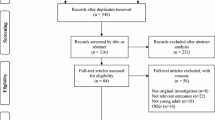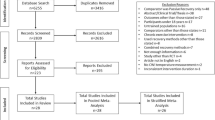Abstract
Background
Partial weight supported treadmill gait training (PWSTT) is widely used in rehabilitation of gait in patient with Parkinson’s Diseases (PD). However, its effect on blood pressure variability (BPV) and baroreflex sensitivity (BRS) in PD has not been studied.
Aim
To evaluate the effect of conventional and treadmill gait training on BPV components and BRS.
Methods
Sixty patients with idiopathic PD were randomized into three groups. Twenty patients in control group were on only stable medication, 20 patients in conventional gait training (CGT) group (Stable medication with CGT) and 20 patients in PWSTT group (Stable medication with 20 % PWSTT). The CGT and PWSTT sessions were given for 30 min per day, 4 days per week, for 4 weeks (16 sessions). Groups were evaluated in their best ‘ON’ states. The beat-to-beat finger blood pressure (BP) was recorded for 10 min using a Finometer instrument (Finapres Medical Systems, The Netherlands). BPV and BRS results were derived from artifact-free 5-min segments using Nevrocard software.
Results
BRS showed a significant group with time interaction (F = 6.930; p = 0.003). Post-hoc analysis revealed that PWSTT group showed significant improvement in BRS (p < 0.001) after 4 weeks of training. No significant differences found in BPV parameters; systolic BP, diastolic BP, co-variance of systolic BP and low frequency component of systolic BP.
Conclusions
Four weeks of PWSTT significantly improves BRS in patients with PD. It can be considered as a non-invasive method of influencing BRS for prevention of orthostatic BP fall in patients with PD.



Similar content being viewed by others
References
Mehrholz J, Friis R, Kugler J, Twork S, Storch A, Pohl M (2010) Treadmill training for patients with Parkinson’s disease. Cochrane Database Syst Rev 20(1):CD007830
Michalowska M, Fiszer U, Krygowska-Wajs A, Owczarek K (2005) Falls in Parkinson’s disease. Causes and impact on patients’ quality of life. Funct Neurol 20(4):163–168
Bloem BR, Beckley DJ, van Dijk JG, Zwinderman AH, Remler MP, Roos RA (1996) Influence of dopaminergic medication on automatic postural responses and balance impairment in Parkinson’s disease. Mov Disord 11(5):509–521
Perez-Lloret S, Rey MV, Fabre N, Ory F, Spampinato U, Montastruc JL et al (2012) Do Parkinson’s disease patients disclose their adverse events spontaneously? Eur J Clin Pharmacol 68(5):857–865
Ganesan M, Pal PK, Gupta A, Sathyaprabha TN (2010) Dynamic posturography in evaluation of balance in patients of Parkinson’s disease with normal pull test: concept of a diagonal pull test. Parkinsonism Relat Disord 16(9):595–599
Ganesan M, Sathyaprabha TN, Gupta A, Pal PK (2014) Effect of partial weight-supported treadmill gait training on balance in patients with Parkinson disease. PMR 6(1):22–33
Li F, Harmer P, Fitzgerald K, Eckstrom E, Stock R, Galver J et al (2012) Tai chi and postural stability in patients with Parkinson’s disease. N Engl J Med 366(6):511–519
Shen X, Mak MK (2014) Balance and gait training with augmented feedback improves balance confidence in people with Parkinson’s disease: a randomized controlled trial. Neurorehabil Neural Repair Jan 9: doi:10.1177/1545968313517752
Sanchez-Ferro A, Benito-Leon J, Gomez-Esteban JC (2013) The management of orthostatic hypotension in Parkinson’s disease. Front Neurol 4:64
Braune S, Elam M, Baron R, Low PA (1999) Assessment of blood pressure regulation. The International Federation of Clinical Neurophysiology. Electroencephalogr Clin Neurophysiol 52:287–291
Goldstein DS (1983) Arterial baroreflex sensitivity, plasma catecholamines, and pressor responsiveness in essential hypertension. Circulation 68(2):234–240
Kardos A, Watterich G, de Menezes R, Csanady M, Casadei B, Rudas L (2001) Determinants of spontaneous baroreflex sensitivity in a healthy working population. Hypertension 37(3):911–916
Szili-Torok T, Kalman J, Paprika D, Dibo G, Rozsa Z, Rudas L (2001) Depressed baroreflex sensitivity in patients with Alzheimer’s and Parkinson’s disease. Neurobiol Aging 22(3):435–438
Iellamo F, Legramante JM, Massaro M, Raimondi G, Galante A (2000) Effects of a residential exercise training on baroreflex sensitivity and heart rate variability in patients with coronary artery disease: a randomized, controlled study. Circulation 102:2588–2592
La Rovere MT, Bersano C, Gnemmi M, Specchia G, Schwartz PJ (2002) Exercise-induced increase in baroreflex sensitivity predicts improved prognosis after myocardial infarction. Circulation 106:945–949
Ditor DS, Kamath MV, MacDonald MJ, Bugaresti J, McCartney N, Hicks AL (2005) Effects of body weight-supported treadmill training on heart rate variability and blood pressure variability in individuals with spinal cord injury. J Appl Physiol 98(4):1519–1525
Bogert LW, van Lieshout JJ (2005) Non-invasive pulsatile arterial pressure and stroke volume changes from the human finger. Exp Physiol 90(4):437–446
Imholz BP, Wieling W, van Montfrans GA, Wesseling KH (1998) Fifteen years experience with finger arterial pressure monitoring: assessment of the technology. Cardiovasc Res 38(3):605–616
Parlow J, Viale JP, Annat G, Hughson R, Quintin L (1995) Spontaneous cardiac baroreflex in humans. Comparison with drug-induced responses. Hypertension 25(5):1058–1068
Parati G, Di Rienzo M, Omboni S, Ulian L, Mancia G (1995) Blood pressure variability over 24 hours: its different components and its relationship to the arterial baroreflex. J Sleep Res 4:21–29
Tank J, Baevski RM, Fender A, Baevski AR, Graves KF, Ploewka K et al (2000) Reference values of indices of spontaneous baroreceptor reflex sensitivity. Am J Hypertens 13(3):268–275
Barbic F, Perego F, Canesi M, Gianni M, Biagiotti S, Costantino G et al (2007) Early abnormalities of vascular and cardiac autonomic control in Parkinson’s disease without orthostatic hypotension. Hypertension 49(1):120–126
Dolan E, O’Brien E (2010) Blood pressure variability: clarity for clinical practice. Hypertension 56(2):179–181
Laude D, Elghozi JL, Girard A, Bellard E, Bouhaddi M et al (2004) Comparison of various techniques used to estimate spontaneous baroreflex sensitivity (the EuroBaVar study). Am J Physiol Regul Integr Comp Physiol 286(1):226–231
Milic M, Sun P, Liu F, Fainman C, Dimsdale J, Mills PJ et al (2009) A comparison of pharmacologic and spontaneous baroreflex methods in aging and hypertension. J Hypertens 27(6):1243–1251
Lanfranchi PA, Somers VK (2002) Arterial baroreflex function and cardiovascular variability: interactions and implications. Am J Physiol Regul Integr Comp Physiol 283(4):815–826
Watkins LL, Blumenthal JA, Carney RM (2002) Association of anxiety with reduced baroreflex cardiac control in patients after acute myocardial infarction. Am Heart J 143(3):460–466
Eckberg DL, Convertino VA, Fritsch JM, Doerr DF (1992) Reproducibility of human vagal carotid baroreceptor–cardiac reflex responses. Am J Physiol 263(2):215–220
Loimaala A, Huikuri HV, Koobi T, Rinne M, Nenonen A, Vuori I (2003) Exercise training improves baroreflex sensitivity in type 2 diabetes. Diabetes 52(7):1837–1842
Iellamo F, Manzi V, Caminiti G, Sposato B, Massaro M, Cerrito A et al (2013) Dose-response relationship of baroreflex sensitivity and heart rate variability to individually-tailored exercise training in patients with heart failure. Int J Cardiol 166(2):334–339
Martinez DG, Nicolau JC, Lage RL, Toschi-Dias E, de Matos LD, Alves MJ et al (2011) Effects of long-term exercise training on autonomic control in myocardial infarction patients. Hypertension 58(6):1049–1056
Kaufmann H, Goldstein DS (2013) Autonomic dysfunction in Parkinson disease. Handb Clin Neurol 117:259–278
Linden D, Diehl RR, Berlit P (1997) Sympathetic cardiovascular dysfunction in long-standing idiopathic Parkinson’s disease. Clin Auton Res 7(6):311–314
Palma J-A, Urrestarazu E, Alegre M, Pastor MA, Valencia M, Artieda J et al (2013) Cardiac autonomic impairment during sleep is linked with disease severity in Parkinson’s disease. Clin Neurophysiol 124(6):1163–1168
Palma JA, Carmona-Abellan MM, Barriobero N, Trevino-Peinado C, Garcia-Lopez M, Fernandez-Jarne E et al (2013) Is cardiac function impaired in premotor Parkinson’s disease? A retrospective cohort study. Mov Disord 28(5):591–596
Werner WG, DiFrancisco-Donoghue J, Lamberg EM (2006) Cardiovascular response to treadmill testing in Parkinson disease. J Neurol Phys Ther 30:68–73
Goldstein DS (2003) Dysautonomia in Parkinson’s disease: neurocardiological abnormalities. Lancet Neurol 2(11):669–676
Goldstein DS, Holmes CS, Dendi R, Bruce SR, Li ST (2002) Orthostatic hypotension from sympathetic denervation in Parkinson’s disease. Neurology 58(8):1247–1255
Conflict of interest
On behalf of all authors, the corresponding author states that there is no conflict of interest.
Author information
Authors and Affiliations
Corresponding author
Rights and permissions
About this article
Cite this article
Ganesan, M., Pal, P.K., Gupta, A. et al. Treadmill gait training improves baroreflex sensitivity in Parkinson’s disease. Clin Auton Res 24, 111–118 (2014). https://doi.org/10.1007/s10286-014-0236-z
Received:
Accepted:
Published:
Issue Date:
DOI: https://doi.org/10.1007/s10286-014-0236-z




